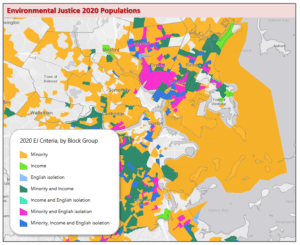Who is a member?
Our members are the local governments of Massachusetts and their elected and appointed leadership.

The Executive Office of Energy and Environmental Affairs web portal includes a data set and GIS maps that identify environmental justice populations across the Commonwealth using 2020 U.S. Census data overlaid with three demographic criteria.
Following the enactment of landmark climate legislation early this year, several state agencies are issuing new guidance or undertaking a stakeholder engagement process related to environmental justice.
According to state policy, “Environmental justice is based on the principle that all people have a right to be protected from environmental hazards and to live in and enjoy a clean and healthful environment regardless of race, color, national origin, income, or English language proficiency.”
The Executive Office of Energy and Environmental Affairs launched a web portal in June featuring the state’s updated Environmental Justice Policy, which now includes the definition of an environmental justice population, as required by the new climate law (Chapter 8 of the Acts of 2021). The policy also now outlines a process by which some neighborhoods may be included or excluded from being designated as an environmental justice population.
The web portal includes a data set and GIS maps that identify environmental justice populations across the Commonwealth using 2020 U.S. Census data overlaid with three demographic criteria developed by the Executive Office of Energy and Environmental Affairs.
The number of municipalities containing an environmental justice neighborhood or block group increased to nearly 200 based on updated data analysis this year.
The Massachusetts Environmental Policy Act Office, under Energy and Environmental Affairs, plans to launch a formal regulatory process this fall, a key focus of which is the requirement under the new climate law that environmental justice considerations be incorporated into MEPA procedures.
MEPA requires state agencies to study the environmental impacts of projects requiring state permitting, financial assistance or land disposition, and to use all feasible measures to avoid, minimize and mitigate damage to the environment.
In recent months, the MEPA office has been revising its environmental justice outreach protocol, issuing interim guidance in advance of the formal regulatory process.
The office is forming an advisory committee of stakeholders to inform the process moving forward. The MMA has been approached about representing municipal interests on the advisory committee, but no official appointment has been made as yet.
The Department of Environmental Protection is developing new provisions for including cumulative impact analyses in certain categories of air quality permits as required under the new climate law. These provisions would also apply to cumulative impact analyses conducted by other state agencies, such as through the MEPA review process.
The MassDEP is holding preliminary stakeholder meetings regarding this effort on Aug. 31 in the afternoon and evening. Recordings of the meetings will be available on the agency’s YouTube channel.
The stakeholder process for developing the cumulative impact analysis provisions will be open to the public and not informed by an advisory committee. To be added to an email list regarding future opportunities for stakeholder engagement in this process, contact Joanne Morin of MassDEP at Joanne.O.Morin@mass.gov or fill out the online form.